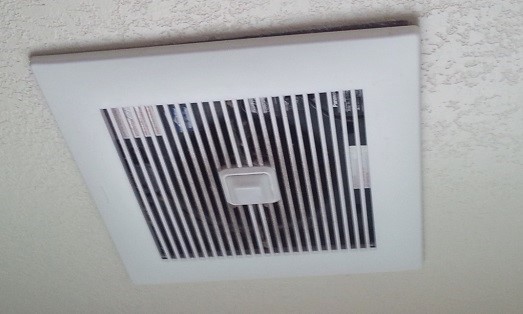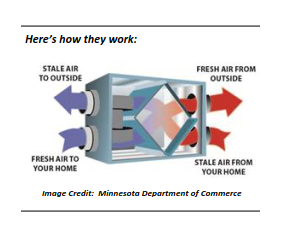Why Ventilate My Home?
Homes without adequate ventilation can experience a variety of problems with indoor moisture, odors and pollutants. Moisture from cooking and bathing need to be removed before high humidity levels lead to mold growth and/or physical damage to the home. Too little ventilation can allow unpleasant odors to linger. Contaminants like formaldehyde and volatile organic compounds (VOCs) can accumulate and may cause health problems in poorly ventilated homes.
Typically, newer or recently air-sealed homes have less natural ventilation, which means these pollutants aren’t regularly flushed out of the home. The issue isn’t that these homes are too “tight”—it’s that they not “breathing” properly. Mechanical ventilation, in the form of exhaust fans, allows homeowners to better control the breathability of their home.
What Type of Ventilation Do You Recommend?

We recommend an ENERGY STAR-rated bathroom exhaust fan or kitchen range hood that is rated for quiet and continuous operation. Fan installation often costs between $500-1200.
These fans typically have two speeds which can be controlled by a motion sensor or switch. The continuous or low speed setting is typically 30-50 cubic feet per minute (CFM). Higher speeds are used when bathing (50-110 CFM) or cooking (more than 100 CFM).
In terms of duration, we recommend running fans on high speed for 20-30 minutes to clear out excess moisture and odors. The fan installer or final inspector will set the exhaust fan ventilation speed depending on the number of occupants or bedrooms and the home’s tightness.
How Does It Work?
The fan’s motor sucks in air from throughout the house and blows it outside through ductwork.
Where Is The Continuous Ventilation Located?
The most common location for the continuous ventilation fan is in the most frequently used bathroom. It should replace whatever fan is already located there. Sometimes a kitchen range hood rated for continuous use is an option, if a home’s structure doesn’t allow the installation of a properly vented bathroom fan. In most cases, one continuously ventilating fan—either in the bathroom or the kitchen—is enough.
How Do I Adjust The Fan Settings?
Fan settings are usually adjusted by removing the fan grate and adjusting the dials. Typically, one dial will adjust the CFM or speed, while the other will determine how long the fan will remain on after being triggered by motion or a wall switch.
What Maintenance Is Required?
Most fans should have the fan grill and body cleaned yearly. Follow the cleaning timeline for your specific model, as outlined by your fan installer.
How Much Will It Cost To Run The Fan All The Time?
We recommend running the fan continuously, 24/7. By running it all the time, the fan can be set at a lower, less noisy speed. Fans typically cost around $7-$15 per year in electricity costs to operate continuously. Other associated costs include exhausting already heated or cooled air from the home.
The savings from air sealing and insulation work are typically much greater than the small amount of air the fan removes from the home. The benefits of healthier indoor air quality by removing indoor moisture, odors, and pollutants usually outweigh the additional cost. Where Does The Air The Fan Is Exhausting Out Come From? The fan is pulling air from air leaks, cracks in your home, and/or a combustion air inlet (a flexible ductwork tube that goes into your mechanical room).
The CFM rate can be increased when indoor humidity is high or there are odors in the home. The fan’s activation period can be made longer if the fan is unable to keep the bathroom it is located in dry. Some fans may also have a switch that is used to set the CFM of the fan at a higher speed.
What are recommended humidity levels in winter?
| When the Outdoor Temperature is (deg. F): | The Relative Humidity Should be: |
|---|---|
| 20 to 40 | < 40% |
| 10 to 20 | < 35% |
| 0 to 10 | < 30% |
| -10 to 0 | < 25% |
| -20 to -10 | < 20% |
| -20 or below | < 15% |
What are balanced ventilation or Heat Recovery Ventilators (HRVs) and Energy Recovery Ventilators (ERVs)?
 HRVs and ERVs are types of balanced ventilation machines, typically tied into the existing ductwork used for the forced air furnace and central air conditioning. Both HRVs and ERVs key advantage over exhaust-only continuous ventilation is their ability to recover heat from the warm air stream and provide good filtration for allergens.
HRVs and ERVs are types of balanced ventilation machines, typically tied into the existing ductwork used for the forced air furnace and central air conditioning. Both HRVs and ERVs key advantage over exhaust-only continuous ventilation is their ability to recover heat from the warm air stream and provide good filtration for allergens.
The main difference between HRVs and ERVs is that HRVs remove humidity from the air stream, while ERVs recover humidity from the air stream. The installation cost of HRVs and ERVs can be two to four times more than a continuous bath fan—usually between $1500 and $2500. Prices vary, so be sure to check with your HVAC contractor for more details on pricing and installation.
